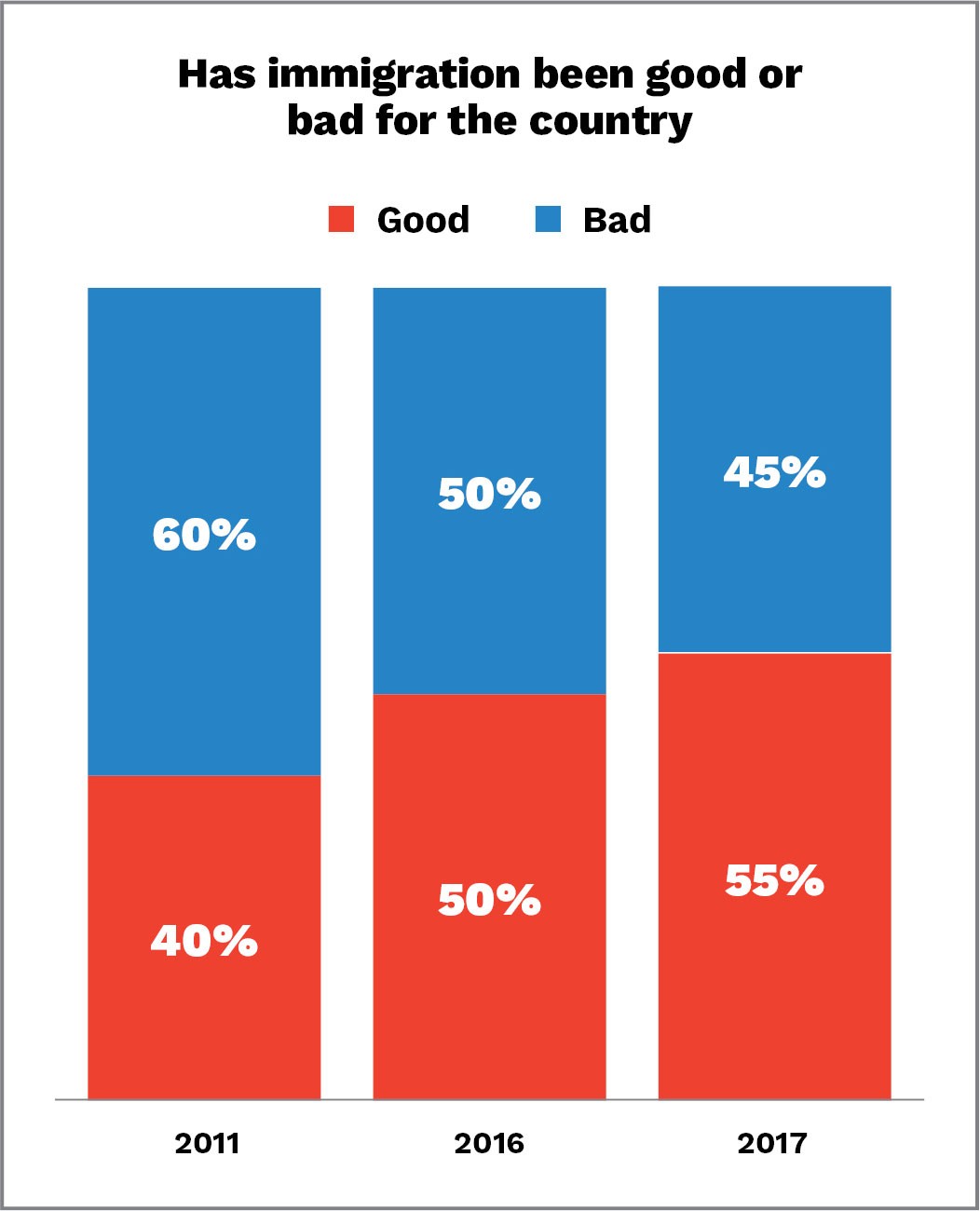HOPE not hate uses cookies to collect information and give you a more personalised experience on our site. You can find more information in our privacy policy. To agree to this, please click accept.
Since we first carried out our Fear and HOPE survey in 2011, a lot has happened. Changing social and economic conditions and key events over…

Since we first carried out our Fear and HOPE survey in 2011, a lot has happened. Changing social and economic conditions and key events over the last seven years have all influenced the way we identify and see others around us.
Here’s some of the most important ways attitudes in England have changed:
1. We’ve become a more liberal society
The proportion of the population in our two most liberal groups – which both have very liberal outlooks – has grown from 22% in 2011 to 39% today, drawing people in from the ‘middle ground’ groups. The liberal tribes have become more mixed since 2011 – now around a third are working in manual jobs and the service industry. However, the proportion of people identifying with the two hostile ‘tribes’ has remained stable and their views have not moderated since 2011.
2. We’ve cautiously felt the impacts of economic recovery
In 2011, the effects of the economic crisis and the onset of austerity cuts were clearly felt and more than half of respondents felt that things had worsened for them over the last ten years, while over 80% felt that things had worsened for Britain as a whole. By February 2016, 62% of people felt things were better in their own lives and 40% thought that things in Britain as a whole had improved. In 2017, the trends look set to have continued, as overall 37% of people feel that things are better for Britain as a whole and 61% of people feel that things are better in their own lives.
The results of the EU referendum had a clear impact on how people feel about the future, and show just how divisive the referendum result and Brexit process could be. Immediately after the EU referendum, it was clear that some felt change was in the air, and the more hostile tribes became far more optimistic. For others, the shock of the result felt like an earthquake that unsettled their outlook on life, shown by the decline in optimism among the more liberal tribes.
3. Fewer people identify with being English than they did in 2011
In 2011, 39% of people identified as English and 50% of people identified as British. In 2017, 34% of people identified as English and 54% saw themselves as British. Just 11% of Black and Minority Ethnic (BAME) identify themselves as English. Across England, national identity is seen as far more important than religion, ethnicity, the country you live in, or any local identity with a city, town, village or local community. The more hostile tribes are more likely to select factors such as “parent born here” or “celebrate British holidays” as the most important to be considered British, reflecting their anti-immigrant views.
4. Support for English nationalists has steadily decreased since 2011
In 2011, 67% of the active enmity tribe and 57% of the latent hostiles group stated that in response to a clash between Islamic extremists and English nationalist extremists, their sympathies lay with English nationalist groups, a pattern which has fallen to 52% and 49% respectively in 2017. The vast majority of people (74%) reject the activities of both Islamic extremists and English nationalists who are considered as bad as each other. In response to a proposed new mosque, 13% fewer people would support a campaign to stop the mosque than in 2011, and 10% more would actively oppose a campaign to stop the mosque. This issue is less divisive than in 2011.
5. We are more likely to see the positives of immigration
More people now (55%) think that immigration has been good for Britain, up from 40% in 2011. Those wanting to stop all immigration permanently are in the minority at just 12%, down from 18% in 2011.
However, there are some clear concerns about immigration: 75% of people think that immigration adds to pressure on public services and 21% of people think that immigration has made it harder to get a decent wage for the work they do. However, we are more likely to meet a consensus as the liberal and hostile tribes are more likely to agree on the things that trouble us than in 2011.
6. The Conservatives have drawn a more working class voter base, while Labour’s support is becoming more liberal, educated and tolerant.
The makeup of the culturally concerned group – which forms the core of the Conservative’s voter base – has changed substantially from 32% C2, DE in 2011 to 50% in 2017. And the party has drawn in a new set of voters: 49% of people who voted for UKIP in 2015 put their trust in the Conservatives in 2017.In 2011, 30% of those supporting Labour came from our two most liberal tribes. Today, this figure has risen to 52%.
As Labour’s support is drawn from more liberal sections of society, so this influences its policies and outlook, pushing the party to even more liberal positions. However, this naturally comes into conflict with the views of its more socially conservative working class supporters and – fundamentally now that Labour has a chance of winning the next election – voters in the seats it needs to win to form a majority.
UKIP’s base has remained relatively constant since 2011, still drawing almost two thirds of its supporter base from the hostile ‘tribes’. It has regained support from the immigrant ambivalent group since 2016.

Right-wing comic Kearse saves the worst material for his anonymous Telegram account HOPE not hate has identified an anonymised Telegram account belonging to the GB…